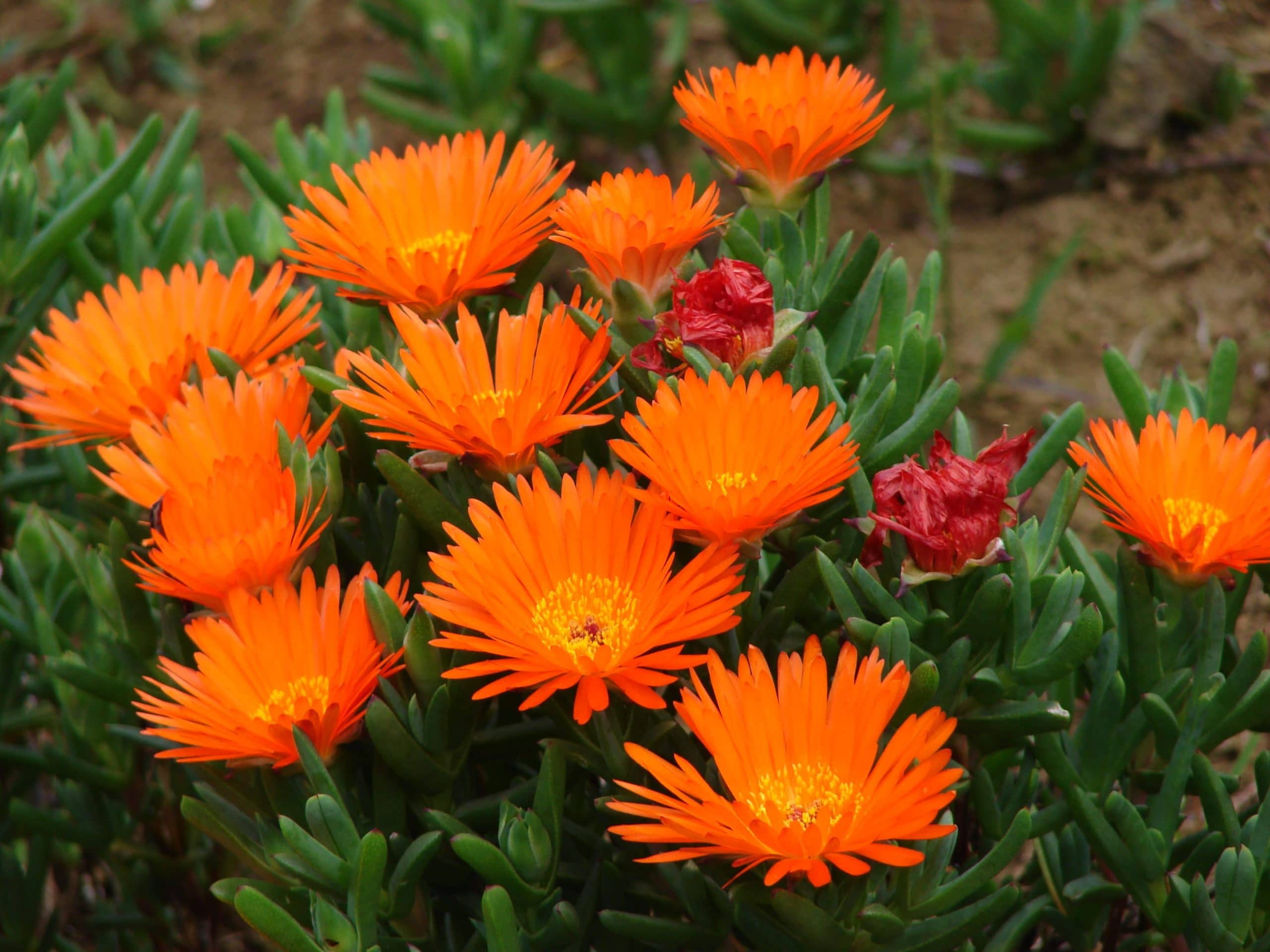
La mesen plant It is a succulent or non-cactus with a very fast growth that is used mainly as a floor covering, although it has an invasive character it is more advisable to have it in a pot or in a planter.
If you would like to know how to take care of it to be able to enjoy its beauty on your patio, terrace or balcony, in this article you will find the information you are looking for.
Origin and characteristics of the mesen plant

Image - Wikimedia / Juni from Kyoto, Japan
The mesen plant, also known as cat's claw, mesen or lamprantus, is native to South Africa and belongs to the botanical genus Lampranthus. It grows as a floor covering, and has fleshy, blue-green, triangular leaves, up to 4-5cm in length. In summer, very showy orange, yellow, red or purple flowers sprout, very bright, 4-5cm in diameter.
As we mentioned, its growth rate is very fast, and it also has the peculiarity that it multiplies very quickly and easily. For these reasons, it is very interesting for beginners since it is a plant that does not usually give problems.
Main species
The best known are the following:
Lampranthus aurantiacus

Image - Wikimedia / Stan Shebs
Its current scientific name is Lampranthus glaucoides. It is a succulent evergreen plant native to South Africa whose height is about 20 to 25 centimeters. Produces orange flowers.
Lampranthus aureus

Image - Wikimedia / Winfried Bruenken (Amrum)
It is an evergreen succulent plant native to South Africa, known as orange mesen or orange mesem. It reaches a height of 30 to 40 centimeters, and produces bright orange flowers.
Lampranthus roseus

Image - Wikimedia / Forest and Kim Starr
It is a relatively small succulent native to South Africa that reaches a height of about 40 centimeters and can spread from 90 to 150 centimeters. Produces pale pink flowers.
Lampranthus spectabilis

Image - Wikimedia / apple2000
It is a succulent plant native to South Africa that grows to a height of 25 centimeters, and an extension of up to 3 meters in length. Its flowers are pink to purple.
What is your Lampranthus care?
If you want to get a specimen of mesen plant, we recommend taking care of it as follows:
Location
Ideally, it should be in the sun throughout the day, but if it is in an area where it receives more light than shade it will also grow well.
Of course, keep in mind that if you are going to grow it in the garden, it is highly recommended that you do not plant it near other plants, because being creeping it could cause problems. To avoid this, leave a space of at least three feet between the Lampranthus and other plants.
Earth
It is not very demanding. As long as it has good drainage, it will develop well. In any case, we advise you:
- Flower pot: fill with universal growing medium alone or mixed with equal parts perlite.
- Garden: if the soil you have is compact or poorly drained (as happens in limestone soils), make a planting hole of about 40 x 40cm and fill it with the mixture of substrates mentioned above.
Another option is to plant it in a flower pot large, about 30cm in diameter, and then in the hole, leaving the container buried.
Irrigation

Image - Wikimedia / Forest & Kim Starr
Irrigation must be very low. If you live in an area where temperatures are mild or warm, and there is little or no rain, it will be enough to water about 2 times a week in summer and every 10-15 days the rest of the year.
If, on the other hand, it rains frequently, it is highly advisable to keep it a little sheltered from the rains, as it does not support flooding or excess water.
Subscriber
From spring to summer you can fertilize it with a liquid fertilizer for succulents following the instructions specified on the product packaging, but it is not necessary.
Planting or transplanting time
If you want to have it in the garden, You must plant it in spring when the risk of frost has passed. If you have it in a pot, it is advisable to plant it in a larger one when you see that roots are coming out of the drainage holes, or when it has already occupied the entire container to the point that it no longer grows.
Multiplication
The fastest way to get new copies is multiplying it by cuttings in summer. It is highly recommended to do it every 3-4 years to be able to continue enjoying the magnificent flowering of the mesen, although in reality it can be done every year without problems since it is a plant that grows fast.
To do this, you have to cut a piece of stem, and plant it in a pot with universal substrate mixed with equal parts perlite, or quartz sand. You water, you place the pot outside protected a little from the sun, and in about 6-10 days it will emit its own roots.
Plagues and diseases
In principle it does not have, but you have to protect it from snails and slugs because its leaves are a real delicacy for these animals. For this you can use diatomaceous earth (for sale No products found.), or molluscicides (be careful with pets, as this product is toxic).
Rusticity
The Lampranthus is a genus of plants that withstand cold and weak and occasional frosts, up to -7ºC. Hail damages the leaves, especially if you have only been growing outdoors for a short time.

What do you think?
Very good and detailed
Thanks for your words, Antonio.